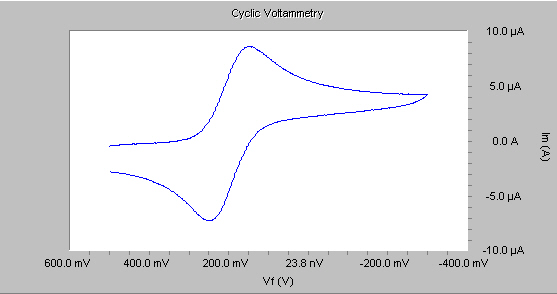Ru Estimation Purpose
Electrochemical test cells always have a solution resistance controlled by the cell’s geometry and the composition of the cell’s electrolyte. Current flow through this solution resistance causes error in the cell’s measured potential.
A three-electrode potentiostat compensates some of the cell’s solution resistance through placement of the cell’s reference electrode. Because reference electrodes are not infinitely small and they cannot be placed infinitely close to the working electrode, this compensation is always incomplete. The portion of the total solution resistance that is left uncompensated is called Ru (uncompensated resistance).
Positive-feedback iR-compensation can be used to correct for the effects of Ru—if the Ru value is known. In essence, positive-feedback iR-compensation circuitry, at a desired potential Ed, applies a potential Ed + iRu (where i is the measured cell current). With this voltage applied between the working and reference electrodes, the electrochemical interface at the working electrode has a potential of Ed.
Unlike some other iR-compensation methods, ideally current-feedback iR-compensation is fast, quiet, dynamically corrects for the iRu error as the cell current changes, and the actual voltage applied to the electrode interface is the same as the potentiostat’s input voltage.
However, there are at least two problems with positive-feedback iR-compensation:
- The value of Ru must be determined or calculated before the method can be applied.
- Excessive compensation can cause instability and oscillation in the potentiostat’s electronics.
The Physical Electrochemistry software includes a script that uses Electrochemical Impedance Spectroscopy (EIS) to make a determination of Ru. The script name is GetRu.EXP. Call this script from the Framework™ menu by selecting Experiment>Utilities>Get Ru.
When the GetRu.EXP script runs, you select a potential, and the EIS determination is made at that potential. Carefully select this potential. In general, the potential used for Ru determination should be free from electrochemical reactions.
For example, the figure below shows the Cyclic Voltamogram of ferrocyanide on a platinum electrode in 0.1 M KCl. Notice the reduction peak beginning at +0.3 V vs. SCE. Above this voltage, no faradiac current is seen. We recommend that the Ru determination in this system is made at 0.5 V vs. SCE.

In EIS, a small sinusoidal voltage is applied to the cell. The resulting current should be a sinusoid at the same frequency, but with different amplitude and phase. If the cell impedance at the applied voltage and frequency is primarily resistive, the phase-angle between the voltage and current should be nominally zero. Phase-angles significantly more positive than zero indicate onset of potentiostat speed limitations, inductive, or capacitive behavior in the cell. Phase-angles significantly below zero are characteristic of capacitive, kinetic, or diffusional control of the cell impedance.
Ideally, measure Ru at the highest frequency at which the phase-angle of the cell impedance is zero degrees. At this frequency, Ru is the “real” portion of the cell impedance.
Many systems have a quite low Ru value, indicating that iR-compensation is not required. The system shown in the figure above has a measured Ru of about 8 Ω. A typical CV current in this system was 10 µA. At this current, the error in the applied voltage in the absence of iR-compensation is 80 µV. In general, iR errors that are less than 1 mV should be ignored, as in this case.
The range and resolution of the positive-feedback iR-circuit is limited. Assume for the moment that positive-feedback iR-compensation is needed for a cyclic voltammetry (CV) experiment. CV is normally done using a fixed-current measurement range. There is an equivalent current-measurement resistance associated with each range. This resistance, known as Rm, can be calculated as 3 V/Current Range. For example, on the 300 mA range, Rm is 10 kW. The maximum iR correction on any range is the value of Rm, and the resolution of the setting is 0.025% Rm. On the 300 mA range, you can set Ru between 2.5 W and 10 kW, with a resolution of 2.5 W.
In general, avoid entering the full measured Ru value into tests that use positive-feedback iR-compensation. A potentiostat is likely to oscillate when fully iR-compensated. We recommend that 75 to 95% of the measured Ru value be applied as compensation. In our example system, with an 8 W Ru, the positive feedback value, if entered at all, would therefore be entered as a value between 6 W (at 80% compensation) or 7.6 W (at 95% compensation).
The Ru value measured here can also be used to correct the data after collection in Echem Analys™t. In that case it is possible to correct for 100% of Ru.

Comments are closed.